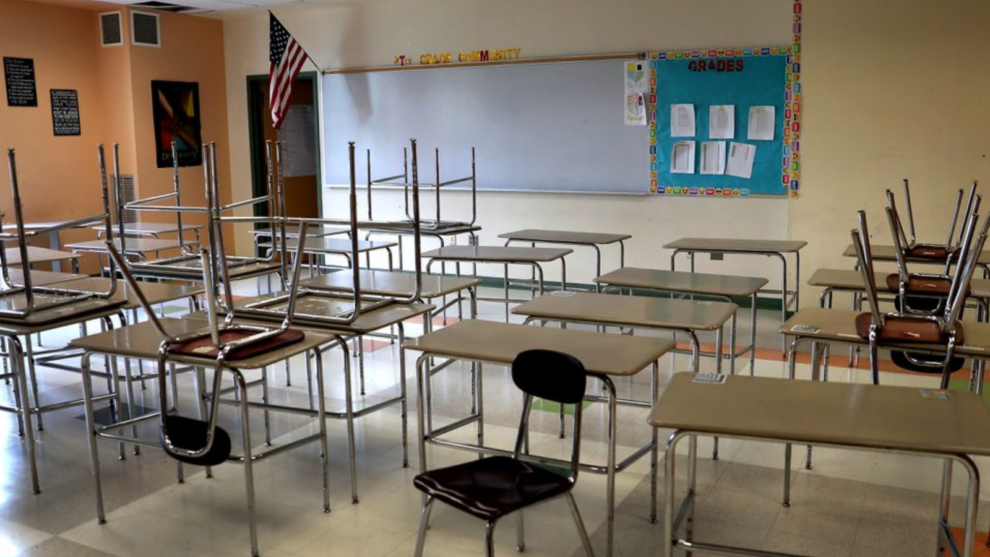
Schools across the country face a burgeoning crisis, which was long-growing but exacerbated by the COVID pandemic. A recent report from the Economic Policy Institute points to a precipitous drop in school employment: “As of December 2021, public elementary and secondary school employment was down 376,300 (or 4.7%) from its February 2020 level on a seasonally adjusted basis.” And that number belies a greater drop over more than a decade: As of 2021, K-12 public education employment is down 432,000. Further, student populations have increased. If schools were to maintain “the same classroom sizes and [staff to student] ratios—K–12 public education employment today would be 658,000 (or 8.6%) higher than it was in December 2021.” Add to that the fact that COVID restrictions and the attendant process of bringing kids back to in-person schooling means staffing needs are greater than they were before the pandemic.
What’s happening? Underpay, COVID risk, and politicization have coalesced to create a perfect storm for school staff shortages. The report points out:
“From 2014 to 2019, the median weekly wage of food service workers in K–12 education was $331 per week (2020 dollars)—less than half the median weekly wage of workers in the economy overall. Similarly, bus drivers and teaching assistants are paid roughly $500 per week—just over 60% of the overall median.”
Many school staffing positions are part-time, compounding the issue of low pay. Even for full-time employees, low salaries mean moonlighting a second job has become a common occurrence for school staff. This table shows just how far teacher salaries lag behind those of their peers.
What are the concrete motivations for teaching, besides the assumption of sweeping benevolence, that teachers and school staff are selfless “heroes” who owe their service to our children? Teachers and school staff are disrespected, underpaid, and under-supported, time and time again, with the only counterpose that they are doing some great service to our nation’s youth. The “teacher as superhero” rhetoric (curiously, those most often referred to as “essential workers” often are paid and respected the least) is no substitute for a livable salary and reasonable working conditions. Schoolwork, after all, is not charity work.
These problems are manufactured. Overwhelmingly, teachers don’t leave their jobs because of classroom issues. Yet, children will be the ones to pay the price. They are the ones who will see favorite teachers leaving, ballooning student-to-teacher ratios, and the inevitable ever-widening inequality as resources and student populations flow to charter and private schools, leaving the poorest and most in-need children to fend for themselves in underfunded public schools.
No one is waiting in the wings and this problem only looks to be getting worse. Another report by EPI details how hard it is to retain current staff. “The share of schools that reported having vacancies to fill grew from two-thirds in the 2011–2012 school year to nearly four-in-five schools by the 2015–2016 school year.” Further, the report notes that schools struggle to find replacements: “The share reporting that it was ‘very difficult’ to fill vacancies nearly doubled, from 19.7% to 36.2%.”
These conditions will be distorted to argue for less public school funding and more charters and private schools. Critics of public education have invested heavily in the theory that the free market will fix our education system.
We find ourselves amid the slow dawning of a great tragedy. One of the central institutions of our democracy is being thrown to the wolves: Public education and the right to equitable education, for all. What lies ahead if we allow the behemoth of privatization to consume this foundation of people-centered government?
There are short-term answers. Schools can use much of the COVID pandemic aid to hire staff. As EPI notes, “many states and localities confronting shortages right now have more capacity to address funding and pay issues than they likely have had in decades. Congressional pandemic relief measures have provided unprecedented levels of federal funding to states, counties, municipal governments, tribal territories, and school districts.” Sen. Cory Booker (D-NJ) introduced the RAISE Act, which provides yearly tax credits, starting at $1,000, to teachers “based on a sliding scale that offers the most credits to teachers working in high-poverty schools.” The President’s FY 2023 Budget proposes some funding that would give money to schools to expand staffing. Among these proposals is the new $1 billion School-Based Mental Health Professionals program, which helps expand social-emotional health supports within schools, where many kids lack access to counselors, nurses, and social workers. These modest proposals do well by increasing education funding, but we need a system overhaul — a recommitment to public education as a necessary public good — to counter the ebbing tide of school resourcing.
We must fund public education to the fullest, pay teachers competitive wages, and concretely (not rhetorically) support a diverse cohort of teachers to take on the charge of entering into dialogue with, supporting, and teaching the next generation.
Schools cannot be a weapon for political jousting. Schools are many things: Playgrounds, gardens, classrooms, open fields, cafeterias, libraries, all of these commonly held spaces. In the midst of swirling political debates in schools, from laws hamstringing open discussion in Florida and Texas schools, to the fight against charter-ization and privatization, we must affirm education’s role not only as a public good, but as the very realization of democracy itself. Education as a public good requires robust investment and support for the humans who breathe life into the schoolhouses and nurture students day in and day out.